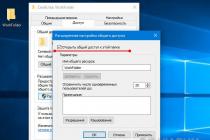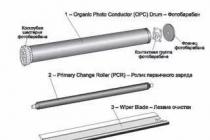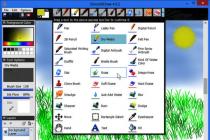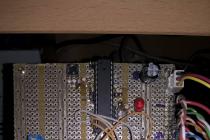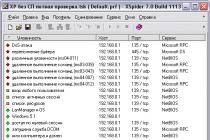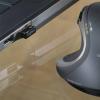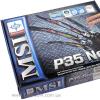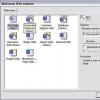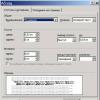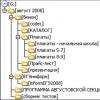|
Today we're going to look at two motherboards based on the P35 chipset: MSI P35 Neo and MSI P35 Neo Combo. Both products are intended for middle-end systems, however, due to the novelty of the chipset, the retail price is quite high. In our opinion, the time of the P35 chipset has not yet come: it does not provide a noticeable expansion of functionality, and also does not provide a performance boost in conjunction with DDR3 memory. As for support for processors with a 1333 MHz bus, there are a lot of boards based on chipsets of the previous generation that officially support such processors. |
Specifications
| CPU | - Intel Pentium 4 (Prescott (2M)/Gallatin/CedarMill) with bus frequency 1066/800/533 MHz;
- Dual-core Intel Pentium D/EE (Smithfield/Presler) with bus frequency 800/1066 MHz; - Intel Celeron-D (Prescott) with a bus frequency of 533 MHz; - Support for Intel Core 2 Duo (Kentsfield (4 cores), Conroe/Allendale (2 cores)) with a bus frequency of 800/1066/1333 MHz; - Support for Intel Yorkfield, Wolfdale with a bus frequency of 1333/1066/800 MHz; - Socket LGA775; - Support for processors with HyperThreading technology; |
|
| Chipset | - Northbridge Intel P35 Memory Controller Hub (MCH);
- Intel ICH9 Southbridge (Enhanced I/O Controller Hub); - Communication between bridges: DMI; |
|
| System memory | - Two 240-pin DDR2 SDRAM DIMM slots;
- Two 240-pin DDR3 SDRAM DIMM slots; - Maximum memory capacity 4 GB; - Supported memory type DDR3 800/1066; |
- Four 240-pin DDR2 SDRAM DIMM slots;
- Maximum memory capacity 8 GB; - Supported memory type DDR2 667/800; - Dual-channel memory access is possible; |
| Graphics | - One PCI Express x16 slot; | |
| Expandability | - Two 32-bit PCI Bus Master slots;
- Three PCI Express x1 slots; - Twelve USB 2.0 ports (4 built-in + 8 optional); - Two IEEE1394 ports (Firewire; one built-in + one optional); - Built-in High Definition Audio 7.1; - Gigabit Ethernet network controller; |
|
| Overclocking options | - Changing the FSB frequency from 200 to 500 MHz in 1 MHz steps; multiplier change;
- Changing the voltage on the processor, memory, PCI-E and chipset (nb & sb); |
|
| Disk subsystem | - 1 channel UltraDMA133/100/66/33 Bus Master IDE (Marvell 88SE6111; supports up to 2 ATAPI devices);
- Support for SerialATA II protocol (4 channels - ICH9); - Support for the SerialATA II protocol (1 channel - Marvell 88SE6111); - Support for LS-120 / ZIP / ATAPI CD-ROM; |
|
| BIOS | - 4Mbit Flash ROM; - AMI BIOS with support for Enhanced ACPI, DMI, Green, PnP Features; |
|
| miscellanea | - One port for FDD, one serial port, ports for PS/2 mouse and keyboard;
- STR (Suspend to RAM); - SPDIF out; |
|
| Power Management | - Wake up from modem, mouse, keyboard, network, timer and USB;
- Main 24-pin ATX power connector; - Additional 4-pin power connector; |
|
| Monitoring | - Tracking the temperature of the processor, system, voltage, rotation speed of three fans;
- Smart Fan technology; |
|
| The size | - ATX form factor, 220mm x 305mm (8.65" x 12"); | |
boxes
Both boards are completely identical.
- Motherboard;
- English user manual + quick start guide;
- CD with software and drivers;
- One ATA-133 cable;
- One SerialATA cable + power adapter (one connector);
- Plug on the rear panel of the case;
And contains only the most necessary components for assembly.
Boards
It's easy to see that both boards have a very similar PCB design. Differences only in the area of memory slots. In particular, the MSI P35 Neo Combo board has four multi-colored slots, two of which are for DDR2 modules, and two for DDR3.
The MSI P35 Neo board also has four slots, but all of them are for DDR2 modules.
Each board has three fan connectors: one 4-pin (for the CPU cooler) and two three-pin. The latter are not used - the chipset's cooling system is completely passive and consists of two heatsinks.
The boards have one PCI Express x16 slot, two PCI slots, and three PCI Express x1 slots.
Both boards have an ICH9 southbridge with a heatsink. As a result, the boards support four SerialATA II channels.
In addition, the boards have an additional ParallelATA/SerialATA controller Marvell 88SE6111.
As a result, seven hard drives (5 SATA + 2 PATA) can be connected to each board. Further, the ICH9 south bridge supports 12 USB2.0 ports: four on the rear panel, and eight more are connected using brackets (not included). In addition, the boards support the Firewire serial bus. To do this, they have an additional controller VT6308P manufactured by VIA.
Accordingly, the boards support two ports each, one of which is installed on the rear panel, the other is connected using a bracket (not included).
Also, the ALC888 audio codec is installed on both boards.
A few words about the network: both boards support high-speed network connection; they have the same RTL8111B controller installed:
The back panel of the boards is the same and has the following configuration:
Let's talk about BIOS settings.
BIOS
The BIOS of the MSI P35 Neo and P35 Neo Combo boards is based on the AMI BIOS version and is unified as much as possible.
In the memory settings section, the following set of timings:
An important parameter that affects performance is setting the memory frequency.
Let's look at the system monitoring section.
Both boards display the current CPU and system temperatures, voltages, monitor the rotation speed of three fans, and have the function of adjusting the rotation of the CPU cooler depending on the CPU temperature.
Overclocking and stability
Before moving on to overclocking, let's look at power converters. Their circuit is the same: PWM of MSI P35 Neo Combo board and MSI P35 Neo board has 3-phase circuit, which has one 3300uF capacitor, four 1000uF capacitors and eight 680uF capacitors.
The overclocking features are also the same.
| Pay | MSI P35 Neo/Neo Combo |
| Changing the multiplier | + |
| FSB change | 200 to 500 MHz (1) |
| Vcore change | up to +0.7875 V (0.0125 V) |
| Change Vmem | 1.8V to 3.3V (0.05-0.1V) |
| Change Vdd | 1.2 V to 1.6 V (0.025 V) |
| Change Vpcix | 1.5 V to 1.8 V (0.1 V) |
| Vsb change | from 1.05 V; 1.15 V |
| Vtt change | 1.2V to 1.6V (0.025V) |
| Change PCI-E | 100 MHz to 200 MHz (1) |
A few words about the MSI D.O.T mode, in which overclocking is carried out exactly when needed. In other words, the increase in the FSB frequency occurs at the time of launching a resource-intensive application (for example, a game). And after exiting the application, the system returns to the regular frequency.
Let's look at the practical results of overclocking. The maximum stable FSB frequency for MSI P35 Neo is 466 MHz; the MSI P35 Neo Combo board has 350 MHz.
Performance
When determining the starting FSB frequency, it turned out that both boards overestimate it by 1 MHz.
Doom 3 equalizes both boards. The MSI P35 Neo3 wins one frame at low resolution, but at 120 fps it doesn't matter. When the resolution is increased, the results are leveled. This shows that in real applications we will not see the difference between the compared boards due to the fact that they are made on the same system logic. But still, it’s worth saying thanks to the MSI engineers, who were able to “squeeze” a little more out of their offspring than competitors. Perhaps this is achieved due to the reduced delays of the memory controller, or perhaps the difference is due to different secondary memory timings that the boards set themselves.
Conclusion
The MSI P35 Neo3 model can be called a worthy representative of the middle price segment on the motherboard market. High-quality performance using long-life capacitors ensures stable operation of this model in a conventional system unit at home or in the office. Also, the board is a good option for those who are aiming for an upgrade and are faced with the choice of a new product, but at the same time want to connect all the remaining devices with a PCI interface. If desired, it is possible to install one expansion card with PCI-Express x1 interface. Support for basic RAID modes will allow you to create simple arrays of hard drives to increase the performance of the disk subsystem. The absence of external digital audio interfaces and FireWire 1394 in this model is a little disappointing, but it is fully justified by the price. In terms of peripheral connectivity, the MSI P35 Neo3 is indeed slightly inferior to some other representatives based on the Intel P35, but, as we have seen, in terms of performance it even outperforms the more expensive competitors. For the average user, given its initial performance, this board will be a good buy.
But for the category of enthusiasts and overclockers MSI P35 Neo3 cannot offer anything outstanding. There is no cooling on the power elements of the processor power system and the 8-pin auxiliary power connector. There are few overclocking options in the BIOS, but all the main functions are present. A small heatsink on the chipset is only enough to cool the P35 at stock frequencies. Therefore, it is not recommended to get carried away with excessive overclocking on this board without additional cooling of the components, although the model has potential.
In this article, we offer a look at another more budget option, designed for fans of overclocking and high-performance systems with modern processors - the MSI P35 NEO motherboard.
Note that in the case when a FireWire controller is installed on this board, the index F is added to the model name, and its name looks like MSI P35 NEO-F.
Specification of MSI P35 NEO motherboard:
|
Manufacturer |
|
|
north bridge |
|
|
south bridge |
|
|
Processor socket |
|
|
Supported processors |
Intel Core 2 Quad-Core / Core 2 Duo / Pentium / Celeron Intel Yorkfield, Wolfdale |
|
System bus, MHz |
1333/1066/800MHz |
|
Used memory |
DDR2 800/667 MHz |
|
Memory support |
4 x 1.8V DDR2 DIMM dual-channel architecture up to 8GB |
|
Expansion slots |
1 x PCI-E x16 |
|
Disk subsystem |
Southbridge ICH9 supports: Optional controller Marvell 88SE6111 supports: |
|
Sound subsystem |
Realtek ALC888 8-channel audio codec |
|
LAN support |
Network controller RTL 8111B (10/100/1000 Mbit) |
|
24-pin ATX power connector |
|
|
Cooling |
Aluminum heatsinks on the northbridge and southbridge |
|
Fan Connectors |
1 x CPU |
|
External I/O ports |
2 x PS/2 keyboard and mouse ports |
|
Internal I/O ports |
8 x USB |
|
Overclocking options |
Frequency change: FSB, PCI-Express, memory. |
|
Equipment |
1 x SATA cable |
|
Form factor Dimensions, mm |
ATX |
|
Products webpage |
The new BIOS version for MSI P35 NEO2-FR/FIR can be downloaded from the official page. |

The MSI P35 NEO motherboard is packaged in a small MSI styled cardboard box. The package notes the support for 1333 MHz system bus and 45 nm processors.

The MSI P35 NEO motherboard package includes:
- two CDs with drivers for Windows Vista and Windows XP;
- user manual and installation instructions,
- cable UltraDMA 133/100/66;
- Serial ATA cable
- I/O panel blank;
- SATA power adapter.

MSI P35 NEO motherboards have a fairly good layout - power connectors and ports are located mainly along the edge of the textolite. Although there are drawbacks - in a not entirely advantageous position, under the PCI slots, there is an FDD connector, and the inserted video card will interfere with opening the latches of the green RAM slots. When upgrading a computer, perhaps many users would like to have three PCI slots instead of the two available, so we will also note this fact as a small drawback of the MSI P35 NEO. Also, I was not pleased with the lack of polymer capacitors that are quite “fashionable” at the present time. It is worth noting that MSI releases the MSI P35 Neo Combo, which supports both types of DDR2 and DDR3 memory, and the MSI G33 Neo with integrated graphics on such a PCB.

To cool the north bridge, a relatively large, but not very high, aluminum radiator is used. Much smaller is the cooler on the southbridge.

Since several sets of logic can be used to fill the PCB of the MSI P35 NEO motherboard, there are empty places for two more SATA connectors, which are installed when using the Intel ICH9R south bridge, and there is also a place reserved for the FireWire controller. In our case, the MSI P35 NEO uses the Intel ICH9 chip, which supports four SATA II ports without the ability to create RAID arrays. An additional Marvell 88SE6111 controller is used to ensure the operation of the IDE port and one more SATA.
For ease of connection, eight internal USB ports and a system panel connector are color-coded.

MSI P35 NEO motherboard has only two PCI slots, three PCIE x1 and one PCIE x16 slot. Of the controllers integrated on the board, one can note a gigabit network card based on RTL 8111B, an eight-channel Realtek ALC888 audio codec, the front-panel connector of which supports connections in HDA and AC`97 formats.

The MSI P35 NEO has only a three-channel processor power regulator, but this fact is not surprising for a board of this class.

The following ports are displayed on the rear panel: two PS / 2 for keyboard and mouse, four USB connectors, COM and LPT ports, an RJ45 connector for network connections and connectors for 8-channel audio.

The MSI P35 NEO motherboard has three fan headers, one of which is 4-pin for the CPU cooler, and the rest are 3-pin for case fans. All connectors are located in different parts of the board, which simplifies the choice of a place for connection.
The MSI P35 NEO motherboard uses an AMI-coded BIOS with a lot of settings. Almost all overclocking settings are in a separate section of the Cell Menu.
Settings required for overclocking:
|
Parameter |
Menu name |
Range |
|
|
Processor technologies |
EIST, CPUID MaxVal, Execute Bit |
||
|
Proprietary smart overclocking technology |
1, 3, 5, 7, 10, 15 % |
||
|
Processor multiplier |
Adjust CPU Ratio |
||
|
System bus frequency |
Adjust CPU FSB Frequency |
||
|
PCI Express bus frequency |
Adjust PCI-E Frequency |
||
|
Divisors for memory |
FSB/Memory Frequency |
1:1.25; 1:1.5; 1:1.67; 1:1.2; 1:1; 1:1.2; 1:1.6; |
|
|
Memory Timings |
CAS, RAS to CAS, RAS Precharge, RAS Act to Prechar, tRFC, tWR, TWTR, TRRD, tRTP |
||
|
CPU Voltage |
|||
|
Voltage on memory modules |
|||
|
FSB voltage |
|||
|
Northbridge voltage |
1.25 - 1.65 V |
||
|
I/O controller voltage |
|||
|
Southbridge voltage |

The BIOS has the ability to activate proprietary technology for automatic overclocking D.O.T. (Dynamic Overclocking Technology), with which you can overclock the processor from 1% to 15%.

To set the memory frequency, there are seven dividers, which can be used to optimally set the frequency during overclocking.

As usual, it is possible to adjust the timings and sub-timings of the RAM, but you can notice the absence of the 1T / 2T Memory Timing setting, which changes the command decoding time.

Wide ranges of voltage settings will quite improve the stability of the system during overclocking. In addition, the levels of critical quantities are very conveniently shown, which will help less experienced users navigate.

In the Hardware Monitor window, you can monitor:
- temperature of the processor and motherboard;
- the speed of rotation of the processor cooler and two case fans;
- voltage on the power lines 3.3V, 5V, 12V, 5V SB and the processor core.
In the "CPU Smart FAN Target" item, you can enable the automatic control of the speed of rotation of the CPU cooler.

The MSI P35 NEO motherboard was able to run at a system bus frequency of 530 MHz. Given the large set of settings in the BIOS, we can assume very good possibilities for overclocking processors with its help.

Testing the audio path based on the Realtek ALC888 codec
Overall Results (RightMark Audio Analyzer)
Performance Testing
The following equipment was used to test the capabilities of motherboards.
|
CPU |
Intel Core 2 Duo E6300 (LGA775, 1.86 GHz, L2 2 MB) |
|
Thermaltake Sonic Tower (CL-P0071) + Akasa AK-183-L2B 120mm |
|
|
RAM |
2x DDR2-800 1024MB PQI PC6400 |
|
video card |
EVGA GeForce 8600GTS 256MB DDR3 PCI-E |
|
HDD |
Samsung HD080HJ, 80 GB, SATA-300 |
|
optical drive |
ASUS DRW-1814BLT SATA |
|
Power Supply |
Chieftec CFT-500-A12S 500W, 120mm fan |
|
CODEGEN M603 MidiTower, 2 x 120mm fans for intake / exhaust |





MSI P35 NEO shows an excellent level of performance for a motherboard in its class.
conclusions
The MSI P35 NEO motherboard is a relatively inexpensive solution with good functionality and good overclocking potential, which, in a sense, managed to exceed our expectations. Although fans of overclocking should take into account far from the most powerful processor power regulator. The cost of MSI P35 NEO is one of the lowest among offers based on the Intel P35 chipset, while it has almost no obvious drawbacks. Unless, perhaps, some future owners would like to see more PCI slots, instead of the same PCI-E x1.
Advantages:
- support for Intel Penryn processors made using 45 nm technology;
- a large number of BIOS settings required for overclocking;
- tested bus capability at 530 MHz;
- 8-channel High Definition Audio;
- low cost for its class.
Flaws:
- lack of official support for DDR2-1066;
- very modest equipment;
- only two PCI slots;
- no external S/PDIF;
- no firewire controller.
We express our gratitude to the company PF Service LLC (Dnepropetrovsk) for the motherboards provided for testing.
Article read 34866 times
| Subscribe to our channels | |||||
|
|
|
||||
Published on PS, we started to explore low-end motherboards that are not perceived by most users as "overclocking" products. Against the background of a similarly priced product called Biostar TP45 HP, the MSI P45 Neo-F motherboard has only one significant advantage - widespread use. When searching for the next review candidate, we decided to find a board that combines the same popularity as the MSI P45 Neo-F, but is neither a direct nor an indirect price competitor for the Biostar TP45 HP. After a short search, such a board was found - MSI P35 Neo.
INTRODUCING YOUR MOTHERBOARD
Launched over a year ago, the MSI P35 Neo comes in a small blue box.
advertising
The front side contains information about compatibility with processors and the supported frequency of the system bus. The reverse side provides information about the main technologies and capabilities:
On the side there is a sticker with the main characteristics:

The delivery set is typical for all MSI motherboards of the lower price category, it includes.

